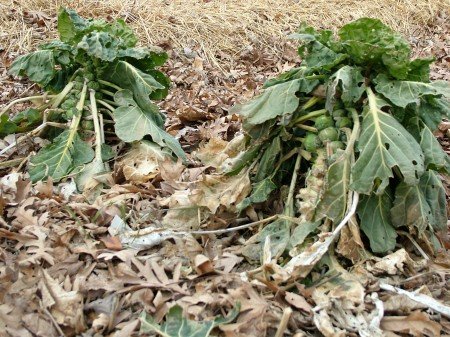The weather in Wisconsin has been super freaky. With highs of 50 yesterday and again today following a December with no snow and exceptionally mild temperatures, a lot of the locals are saying, “what the hey, this ain’t all bad!” I have to say yes and no. It’s kind of scary, and from a gardener’s perspective, in most ways not so good.
I love a deep snow cover on my garden beds. The snow offers insulation and moisture. And too many frost-free days can force perennial plants and trees to bud early. If a cold snap does come after plants put out some tender new growth, serious damage can follow. So while I’m enjoying the unusual warmth, I’m actually hoping things get back to normal.
An unexpected bonus of the warm weather was a January harvest of Brussels sprouts. I’d given up for dead the mangy looking plants in the picture, but when I was checking things out in the garden this afternoon I found a nice harvest of sprouts in very good shape. It did get down to six degrees a couple nights ago so I thought the sprouts would have succumbed to frostbite, but tonight we’ll enjoy fresh sprouts in January. Hooray for global warming?


I agree! It’s been a weird… year?
At least you got delicious sprouts! Yumyum!
You know what’s also freaky? I have Broccoli I direct-seeded last spring, and collected the florets as they grew, usually a small bowl full each week or so. I made no harvests from November till now – the broccoli is STILL producing like crazy! I’m going to have some broccoli tonight!
I am amazed and frightened at the same time…
We’re having the same syndrome in Colorado’s Front Range. The collards often live through the winter, but they’re GROWING. I think it’s interesting that the new USDA zone map just came out. I think it will reveal a ‘growing’ trend of higher zones marching north.
Ryan,
Thanks for the comment. I’ve been in Wisconsin since 1986 and it’s definitely a lot warmer now than when I moved here. Climate change may be good for Wisconsin as far as gardening goes, but overall I foresee major problems. By the way, those interested in the new USDA zone map, it’s pretty cool: http://planthardiness.ars.usda.gov/PHZMWeb/